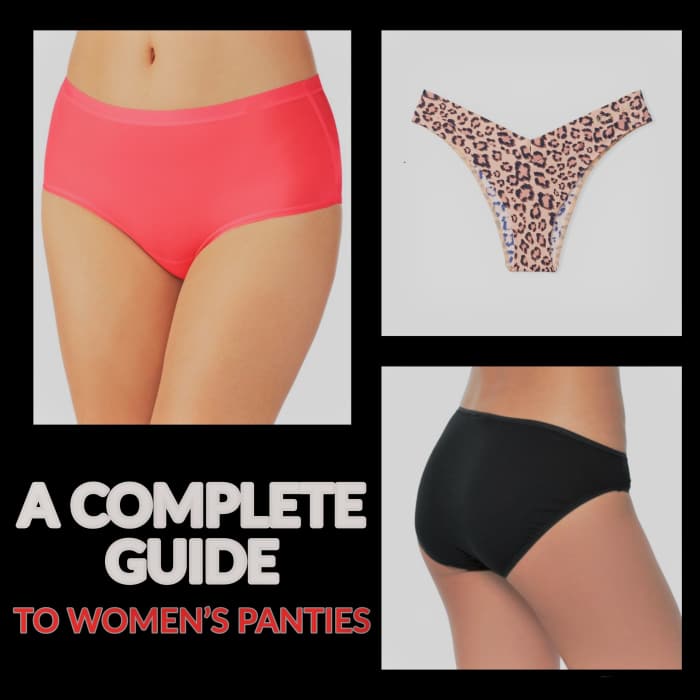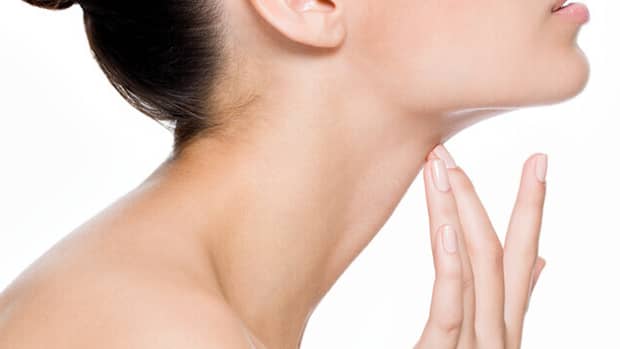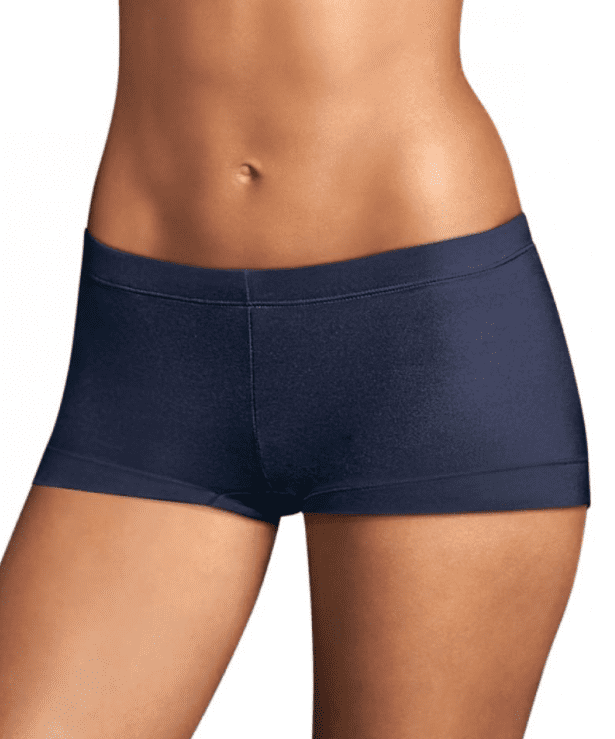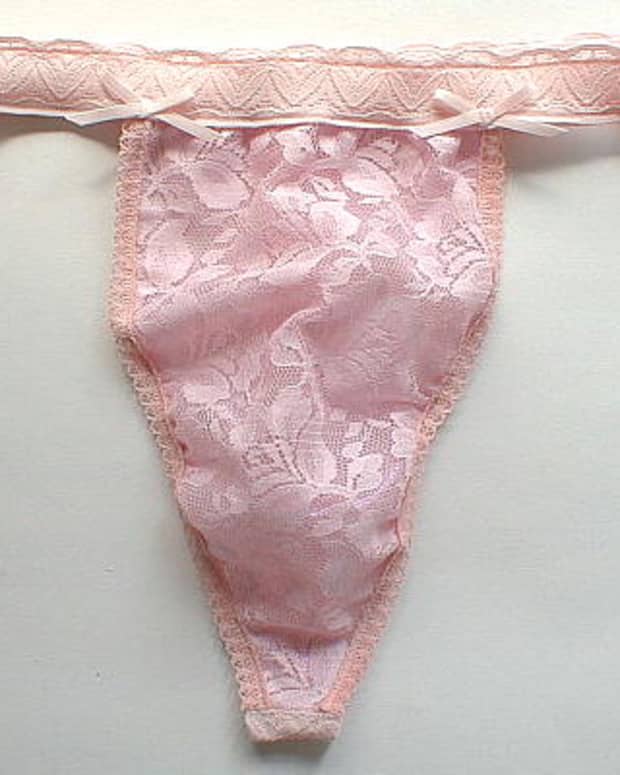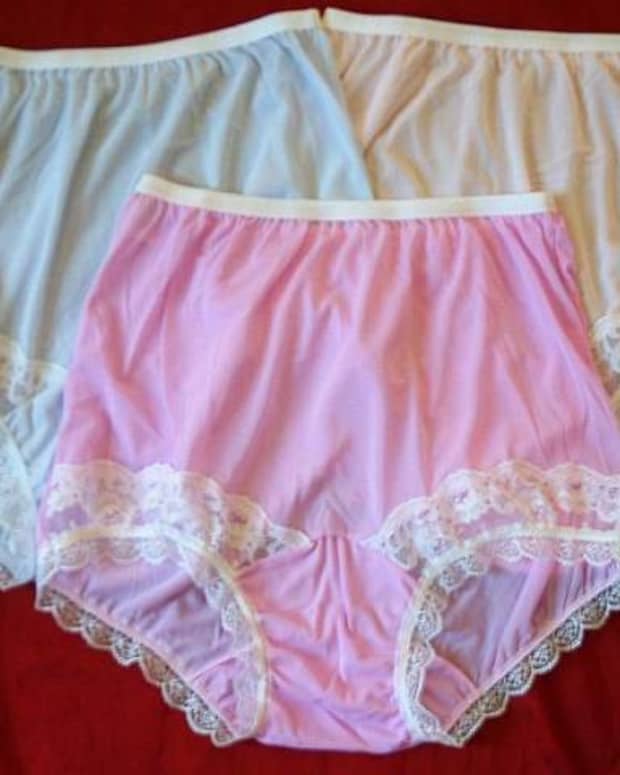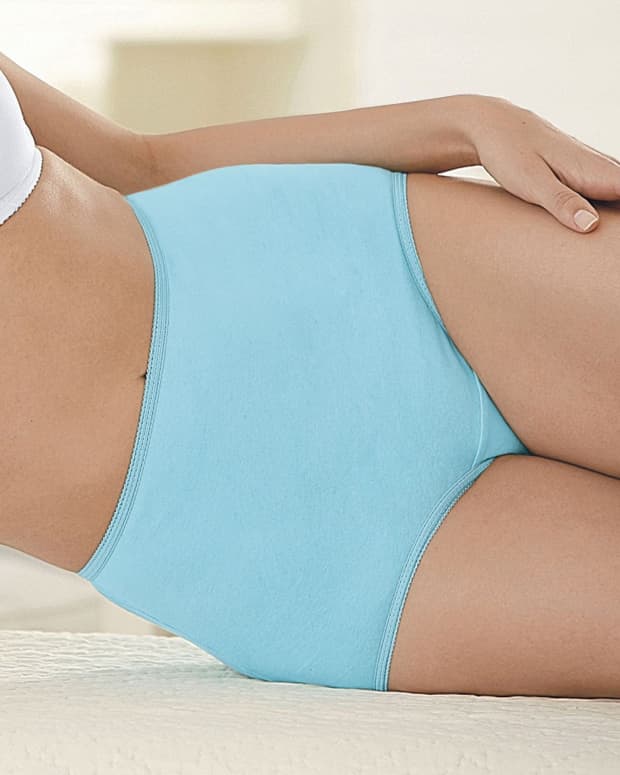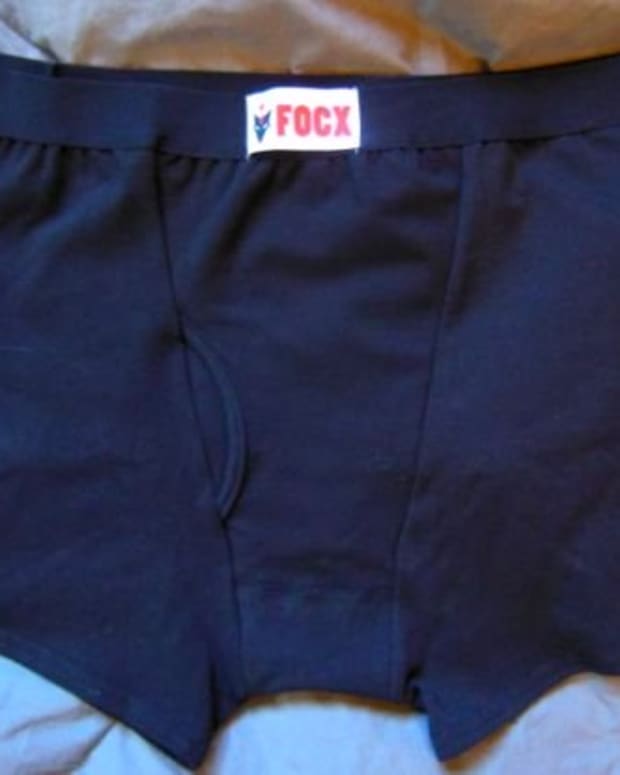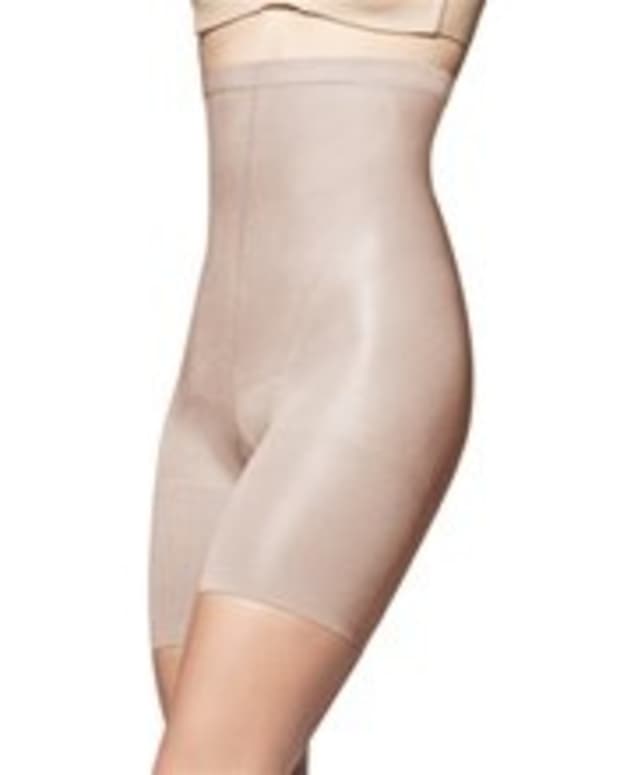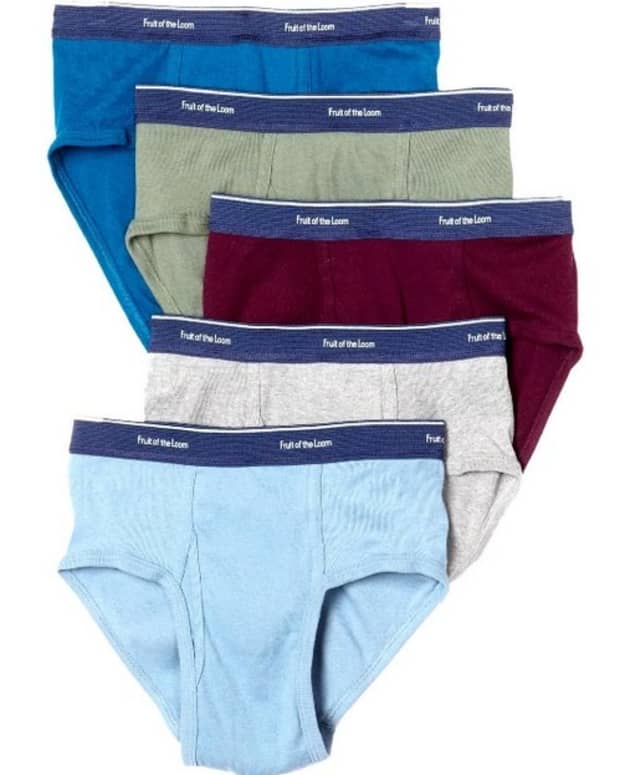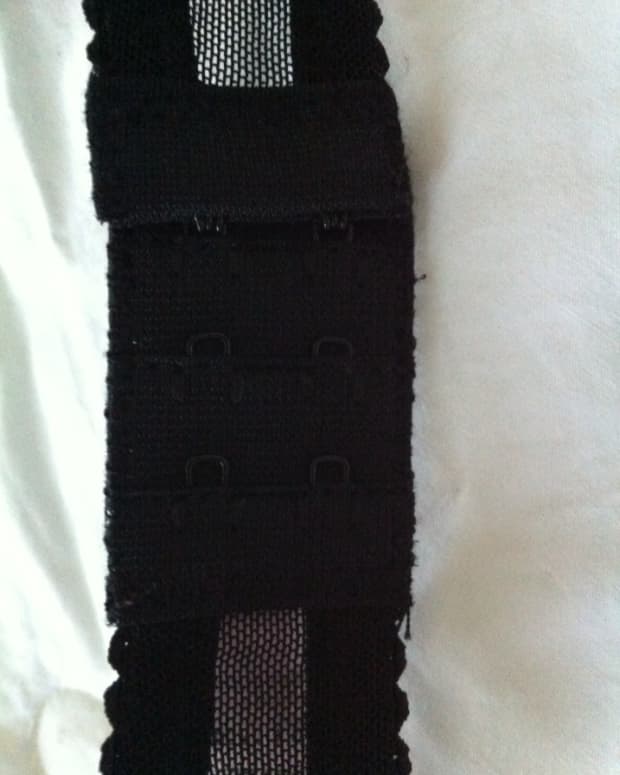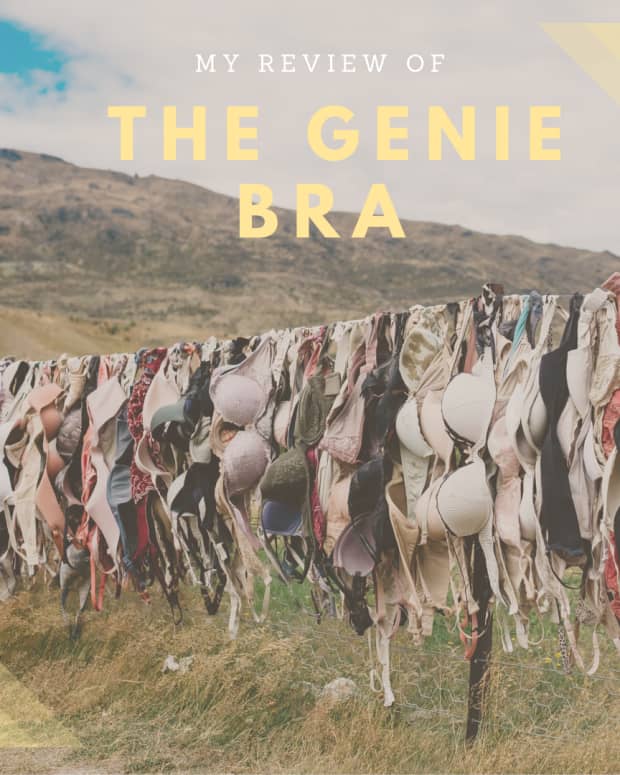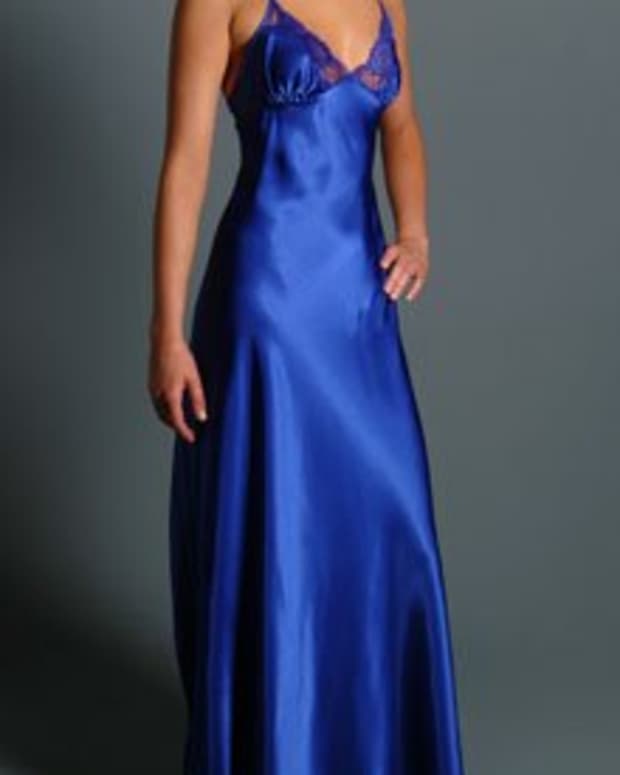A Complete Guide to Women's Panties
Rachel Anders is a formal model and fashion enthusiast. She has tremendous insight into current fashion trends and styles.
Choosing the Right Panty Style
In the realm of clothing, women are afforded great flexibility in regard to their underwear preferences. This is due, in part, to the wide array of fabrics and styles that are available to consumers. From thongs to “cheekies” (and everything in between), the opportunities for creative combinations (and styles) are endless and limited only by the extent of an individual’s imagination.
Knowing which style and fabric to choose, however, comes with its own host of problems as many women are unsure which panty style is best-suited for their particular needs. This article provides an in-depth analysis of the various fabrics, materials, and underwear styles that are currently available to women. It includes a complete overview of each panty style, as well as their suitability for everyday use. Following completion of this work, it is the author’s hope that her readers will be better-equipped to understand the various options that are available on the market. While unseen to the outside world, proper selection of panties is a vital component to any outfit. As such, a deeper understanding of panties can play a major role in amplifying a woman’s overall comfort, confidence, and sense of style.
How to Choose the Right Panty Fabric
Fabric for women’s underwear and lingerie is extremely diverse, providing ladies with an almost “unlimited” selection that fits their individual bodies and needs. In fact, most ladies will tell you that fabric is one of the single most important factors when choosing panties (even more so than style). Why is this the case? Both “breathability” and comfort are extremely important to how you look and feel. Likewise, both of these factors can go a long way in preventing unnecessary sores and infection of your delicate areas.
Before selecting a fabric, however, ladies should consider a number of factors. This includes the fabric’s overall stretchiness, weight, look, and feel. Each of these factors are pretty self-explanatory, and are dependent upon your individual preference. For stretch and weight, do you desire a close-fitting (snug) material or one that that is slightly loose? Likewise, do you want a thicker material, or one that is thinner and more breathable? Finally, and crucially, for “look” and “feel,” you should always ask yourself: “is this material right for me?” Is it comfortable, and does it make me feel secure?
Listed below are some of the most common fabrics available on the market today.
Cotton
As with many clothing options, cotton is perhaps the most popular fabric for panties due to its level of comfort and breathability. Cotton is appropriate for everyday use, and is capable of absorbing upwards of 25-percent of its weight in moisture (keeping your skin dry throughout the day). They are also quite affordable, and highly recommended by many gynecologists due to their breathability and infection-fighting potential. And while the overall price of cotton has certainly increased over the last few years due to growing demand issues, cotton remains one of the most affordable fabric options on the market today.
Satin
Satin is renowned throughout the world for its soft and smooth texture that feels great to the skin. While it is often used in lingerie (due to its flashier appearance), satin is a popular choice for looser-fitting panty styles. It is cool to the touch, making this fabric extremely comfortable. And while it is quite shiny, this fabric is generally suitable for everyday use. Moreover, consumers can expect satin prices to be moderately cheap in price; however, this is subject to change when satin is combined with other fabrics (such as silk) which can dramatically increase its overall value.
Lace
Similar to silk, lace is usually reserved for fancier underwear such as lingerie and nighties. The material is renowned for its light and transparent qualities, along with its “seamless” feel. Despite these qualities, lace is extremely thin and flimsy. Moreover, its rougher texture can cause irritation (including itching) over time if continual contact with the skin is maintained. For these reasons, lace is usually not recommended for everyday use as they can be quite uncomfortable over longer periods of time. In regard to price, expect panties with lace fabric to be much more expensive than cotton and satin alternatives, as this material is considered a luxurious fabric that is in high-demand by consumers.
Mul Mul Cotton
Originating in Northern India, mul mul cotton (sometimes referred to as “mal mal”) is a softer and slightly thicker alternative to regular cotton. It is extremely light and feels great against the skin due to its natural “cool to the touch” texture. Generally speaking, this fabric is suitable for everyday use. However, it is vital to note that mul mul cotton is far less-breathable than standard cotton. This, in turn, increases the risk of skin-related issues when worn for extended periods of time. In regard to price, mul mul cotton is a relatively expensive fabric due to its fine weave and texture. Due to its widespread availability though, it is important to note that mul mul cotton has experienced a slight decrease in cost over the last few years.
Silk
Silk is typically reserved for making lingerie due to its softness and overall texture. Silk has a “weightless” dimension to it, and feels incredibly smooth against the body. It is also quite cool to the touch, providing incredible comfort to the wearer. Nevertheless, silk is usually not an “everyday” option in the realm of panties as it is not a breathable material. This is problematic, as the material can result in unwelcome infections of your delicate areas over time. In spite of this, the fabric is incredibly durable and will hold its shape for longer periods of time when compared to other choices (such as cotton or spandex). Durability comes at a price, however, as silk is generally more expensive than other panty fabrics on the market.
Jersey
Jersey is a material comprised of cotton, wool, nylon and polyester. It is waterproof and is a favorite for bikinis and water-based attire. Generally described as “springy” and “stretchy” in its overall texture, jersey materials offer a great deal of support as they move freely with the body. Jersey is also quite warm due to its knitted quality. This makes it an ideal choice for colder months. In regard to price, jersey is considered a middle-of-the-road option for many individuals, as it is neither cheap nor expensive.
Spandex (Elastane)
Spandex (sometimes referred to as “elastane”) is a super-stretchy material that is usually combined with cotton. The material is a great choice for athletes and more-active individuals, as its stretchiness provides maximum flexibility, while its cotton component actively “wicks” away sweat from the body. This, in turn, helps the wearer stay dry and comfortable during intense workouts. In spite of this, spandex does not provide a great deal of “breathability,” and can trap heat. This creates a perfect breeding ground for yeast infections over time (healthline.com). Price is also a factor that should be considered when looking at spandex, as this material is slightly more expensive than other fabrics (due to the cost of labor required to manufacture it). Nevertheless, price for this material is still considered to be reasonable, as it is not classified as a “luxurious” fabric.
Organza
Organza is a sheer and transparent material that is often adorned with a touch of “sparkle.” As such, it is generally used for lingerie (or gowns) due to its flashy appearance, and soft texture. While this material can certainly be incorporated for daily usage, individuals seeking a fabric that is comfortable and breathable will be better served by cotton-like materials instead. Moreover, it is important to note that organza is generally more expensive than the other fabrics included on this list due to their luxurious finish and design.
Florence Net
Florence Net is an extremely strong and durable fabric that is stretchy, lightweight, and breathable. Virtually weightless (and soft to the touch), this particular fabric is a favorite for lingerie items and nighties. In spite of this, Florence net is usually not recommended for everyday use. While extremely comfortable and breathable, they are not as durable as other fabrics on this list and may tear (or rip) over extended periods of time. Likewise, Florence net is generally more expensive than other options on this list.
Linen
Linen is an extremely breathable fabric that is capable of absorbing upwards of 20-percent of its weight in moisture. As an all-natural fiber, it is also incredibly lightweight, and softer than most of the fabrics on this list. Linen is generally available in both knit and woven forms, and is a great choice for summer attire due to its breathability. For these reasons, it is usually suitable for everyday use. It is important to note, however, that linen is usually characterized as a luxurious material due to the costs associated with harvesting and producing it. As such, linen-based panties are usually much more expensive than cotton-based alternatives.
Merino Wool
Merino Wool is one of the softest fabrics in the world, as well as one of the most breathable (due to its porous fibers). This fabric will not only keep you comfortable and dry throughout the day, but is also great at regulating your body’s natural temperature (keeping you cool in the summer, and warm when it is cold). As a result, this fabric is generally suitable for everyday use and can be easily incorporated into a variety of panty styles. It should be noted, however, that this particular fabric is incredibly expensive due to the number of fibers present (nearly double that of cotton).
Tencel
Tencel is an extremely breathable fabric that is derived from eucalyptus trees. It is comprised of super small fibers (known as nanofibrils) that actively wick away moisture from your skin. This fabric is highly durable, as well as extremely comfortable (making it suitable for everyday use). Nevertheless, women who are interested in this fabric choice should note that Tencel is also a lot more expensive than other options on this list. This is due (in part) to the technology required for its development, as well as its perception as a luxurious fabric by the public.
Read More From Bellatory
Panty Buying Tips
Know Your Body and Personality Type
As with any type of clothing, it is vital that you understand your body type when selecting panties. Some styles are more appropriate than others, depending on your overall shape. Likewise, panties are designed for a wide array of personality types, seasons, and purposes. If you are more modest, for example, choosing a thong or G-string probably isn’t the best choice as the lack of coverage will leave you feeling both vulnerable and exposed. Similarly, fabric choice should be dependent upon the time of year that you plan to wear it. Lighter materials will not offer much protection during the winter, whereas heavy materials will often prove problematic in the summer months.
Know Your Size
Before selecting panties, it is also crucial that you understand your waist and hip size before you begin shopping. Buying a set of panties that is too large (or too small) can result in extreme discomfort for the lady, as well as cause irritation. As such, finding a “perfect size” that fits your particular body shape is an essential part to panty shopping. After determining your particular size and needs, shoppers should also spend considerable time researching different brands as sizes can vary significantly between companies. Again, a proper fit is a vital component to panty selection, and will go a long way in making sure that your panties are as comfortable as possible.
Panty Styles
Now that we have covered the basics of panty fabrics, as well as the importance of size, we can now turn our attention to the various panty styles that are available on the market. In the sections that follow, a detailed overview of each style is provided, followed by a subsection that discusses each style’s “suitability” for everyday use. When selecting a style, always examine “why” you are interested in this particular look. As with any clothing option, some styles are more preferable to women than others. Likewise, some women may find some of these styles to be extremely revealing or uncomfortable for everyday use.

Bikini style panties (viewed from the back). Notice how this style is similar to regular briefs but with slightly less coverage.
Bikini Panties
Bikini-style panties offer an “in-between” option for briefs and thongs, and were inspired by bikini bathing-suit bottoms (as their name implies). Offering medium (moderate) coverage to the wearer, a bikini’s waistband usually sits between the bellybutton and hip (unless they are low-rise). They also have relatively high-cut leg openings and offer a fair amount of coverage in the back. Straps on the side of bikini briefs are generally thin, while the rear fabric sits relatively high on the cheeks. Bikini briefs come in a variety of colors and fabrics that are designed to fit nearly any preference. A string option is also available and is distinguishable by its thinner sides and higher-cut legs.
When to Wear Bikini Panties
Bikini briefs are appropriate for nearly any occasion. Considered highly-versatile due to their size and shape, bikini underwear can be worn with nearly any outfit. This includes skirts (regular or mini), jeans, pants, or dresses. Although panty lines are relatively invisible with this style, certain fabrics (and bottoms) tend to show more than others. So be sure to keep this factor in mind when choosing bikini panties for your wardrobe.
Boyshorts
As their name implies, boyshorts are modeled after men’s boxer briefs and maintain a rectangular appearance similar to hipsters. This style offers full coverage to the wearer, with most sitting below the crease line of the cheek. Some boyshorts even reach as far as the thigh in their length (depending on your particular preference). Generally speaking, these panties tend to sit at the hips with significant coverage on the side regions. However, two major exceptions to this rule can be seen with bootyshorts and girlshorts, which tend to show more “cheek” and sit lower on the waist.
When to Wear Boyshorts
Boyshorts are regularly described as one of the most comfortable styles of panties on the market, with numerous fabrics to choose from (including cotton, nylon, and microfiber materials). As a result, they are great options for sleepwear and athletic attire. Seamless versions work great with skirts, dresses, and tighter-fit clothing. It should be noted, however, that normal boyshorts are prone to show panty lines. As a result, they should typically be worn with loose-fitting jeans, skirts, or pants if this is an issue you wish to avoid. Nevertheless, women seeking a full-coverage design can’t go wrong with boyshorts, as their total cheek coverage offers both a comfortable and modest style that is hard to beat.
Hipsters
Hipsters are often described as a mixture between bikinis and boyshorts. Offering a good deal of coverage, the hipster style maintains a wider waistband that tends to hug the body and hips (as their name implies). Often described as a “square cut,” hipsters are usually accentuated by bikini-style leg holes, along with full coverage in the rear. Generally speaking, these panties often sit low on the hips with the openings sitting just below the crease-line of the cheek. They also come in a variety of colors and fabrics that are tailored to fit nearly any individual’s preference.
When to Wear Hipsters
Hipsters are appropriate for nearly any occasion, and fit a wide-array of clothing options. They generally offer full coverage to the wearer, and are considered extremely comfortable by modern standards. Due to their low-cut features, panty lines are also less visible with this particular style. For these reasons, they are appropriate for almost any outfit, including dresses, skirts, tighter pants/jeans, and shorts (depending on their length).
Tap Pants
Tap pants are a sexy version of the boyshort that were designed to be relatively loose. Originally developed for tap dancers (hence their name), this panty style is often designed with delicate fabrics (such as silk or lace), making them extremely comfortable alternatives to other styles. Tap pants offer full coverage to the wearer (both front and back). In addition to their loose-fitting design, leg openings are usually quite open on this style with the waistband being the only piece of fabric that hugs the skin.
When to Wear Tap Pants
Despite their relatively longer length, tap pants are traditionally worn with skirts or dresses due to their loose-fitting design and lack of panty lines. Due to their extreme comfort (similar to men’s boxers), they are also well-suited as sleep attire.
Briefs
Briefs refer to standard underwear for women. Offering great coverage, briefs sit on (or just below) the bellybutton, and come in a variety of fabrics/materials. While similar to bikini underwear in many ways, briefs tend to have extra coverage along the hip, with additional material also appearing in the legs and rear. This style is also quite thick, and can provide a great deal of support to the tummy area when worn properly.
When to Wear Briefs
Briefs can be worn with any clothing option, and are widely considered to be one of the most comfortable options on the market. Their full-cheek coverage is also a great choice for individuals that prefer modesty over sexiness. However, due to their thicker fabrics, briefs are prone to show panty lines around the edges. For this reason, they are best suited for jeans and thicker clothing. It is also important to note that individuals (when selecting briefs) should attempt to find a pair that won’t bunch up, or “ride up” in the back.
Hi-Cut Briefs
Hi-cut briefs (or high-waisted briefs) are an extremely comfortable style of panties that sit just below the belly-button. Hi-cut briefs offer exceptional coverage to the back and front, and provide additional tummy support/shaping. Possessing wider leg openings, hi-cut panties also give the appearance of “longer legs” due to their relatively thin sides. Generally speaking, hi-cut briefs are simply briefs that sit higher on the waist. And while this panty style experienced a lull in popularity for a short while, it has recently experienced a dramatic revival in recent years as women come to recognize their overall comfort and support.
When to Wear Hi-Cut Briefs
Hi-cut briefs are a great choice for outfits that involve high-waisted bottoms. They are also great for providing a comfortable layer between your skin and high-cut jeans that normally cause discomfort. As a result, this particular style is highly suitable for everyday usage, and can be incorporated into a number of outfit options. As with regular briefs, however, it is important to note that this particular style can show “panty lines” around the edges. For this reason, they are best-suited for jeans, thicker clothing, or loose-fitting dresses and skirts.
Full Briefs
As their name implies, full briefs are designed for maximum coverage to the wearer. Classic styles typically sit high on the waist, and are designed with thick sides along with a lower leg line. Sometimes referred to as “granny panties,” full briefs provide a great deal of support to the wearer, especially along the tummy section and lower back. They also provide a great deal of protection against rougher fabrics (such as jeans and denim), affording women a greater degree of selection in regard to their wardrobe preferences.
When to Wear Full Briefs
Full briefs are generally designed for women who desire full coverage and support. As such, they are suitable for nearly any occasion and can be worn with dresses, skirts, and jeans. Due to their design, however, women should note that this particular style is more likely to show panty lines with tighter-fitting attire. For outfits that are more form-fitting, individuals will be better-served by “cheekier” options such as the thong, tanga, or bikini-cut styles.
Brazilian Briefs
Brazilian briefs, also referred to as “Brazilian knickers,” are a cross between the bikini and thong styles of underwear. These panties tend to sit low on the waistline, and possess wide sides along with minimal coverage in the back (providing a “cheeky” appearance to the wearer). Brazilian briefs are considered extremely sexy in the realm of panties, while simultaneously giving the appearance of regular briefs in the frontal region. For individuals wanting to transition (slowly) from bikini to thong, this style may be a perfect choice.
When to Wear Brazilian Briefs
Brazilian briefs are usually suitable for any outfit due to their comfort, and lack of visible panty lines for the wearer. And due to their coverage on the sides and front, they are even acceptable for jeans as they provide an extra layer of protection against the harsh feel of denim on the body. It is important to note, however, that this particular style has a tendency to “ride up” on the wearer, making them an uncomfortable choice for some women. To avoid this issue, always select panties that are properly fitted to your specific size. Likewise, choose fabrics that fit your particular tastes in regard to comfort.
French-Cut Panties
French briefs are similar to normal briefs, but possess wider sides that wrap around to the back. Generally speaking, French-cut briefs offer minimal coverage in the back as the bottom zone of the cheeks are exposed. Nevertheless, they offer considerable coverage in the front as they sit at the wearer’s natural waistline while hugging the natural curve of the legs. While some ladies look at this style as “granny panties,” their extreme comfort is difficult to beat in the realm of underwear and should definitely be a part of every woman’s attire.
When to Wear French Briefs
Due to their coverage, French briefs are suitable for nearly any outfit. They are extremely comfortable, sit securely along the hips, and are highly-suited for tummy control. In spite of these clear positives, however, it is important to note that this particular style is generally not suitable for low-rise pants (or shorts), as the top portion of your French briefs will be highly visible. Likewise, visible panty lines can be an issue with this style as well (depending on the particular fabric that you choose).
Cheekies
Cheeky panties are often described as a “cross” between the thong and bikini (similar to Brazilian briefs). Sometimes referred to as “cheekies,” the thong-like origins of this particular style are clearly evident upon first glance as these panties tend to reveal more of the lady’s lower bottom. Likewise, they follow a similar design to traditional bikini-cut patterns, but are slightly more revealing and “flirty.” Due to their coverage and thickness, this particular style is also incredibly comfortable to the wearer, and will provide your cheek area with a great deal of support. As a result, this style rarely “rides up” on the wearer (as long as a proper fit is obtained by the lady)
When to Wear Cheeky Panties
Cheeky underwear is a highly practical panty style that is suitable for nearly any occasion. They can be worn with dresses, skirts, and even jeans (providing an extra layer of protection against the rough feel of denim). Cheekies are also well-suited for tighter-fitting clothing as panty lines are virtually non-existent with this particular style. This is due to their back panels, which are far narrower than traditional panties, allowing them to practically “disappear” under your pants and skirts. Likewise, their low-cut design makes them a perfect choice for low-cut jeans.
Tanga
Tanga underwear is an extremely comfortable panty style that offers moderate to minimal coverage for the wearer (depending on your overall preference and style). Often described as a cross between the bikini and thong (similar to the cheeky), tanga underwear showcases much of the lady’s rear, while still maintaining a sense of coverage. They are also slightly narrower than a traditional bikini, providing minimum coverage on the front and sides for the wearer.
When to Wear a Tanga
Tanga style panties are appropriate for nearly any occasion due to their skin-hugging design and lack of panty lines. As such, they can be easily incorporated into nearly any outfit, with dresses and skirts being among the most popular combinations with this style. Due to their “minimal” style, however, it is important to note that tangas can be uncomfortable under jeans and rougher materials, as more skin will be in contact with these particular fabrics (leading to irritation and discomfort in your more sensitive areas).
Thong
Thong panties are one of the most sought-after forms of underwear, and come in a variety of patterns and fabrics. Although they look like normal panties from the front, a thong narrows to a thin piece of fabric in the back where it sits snugly between the cheeks. As a result of this narrowing, waistbands are usually quite narrow in appearance. While they are considered unconventional (due to their minimal coverage), a thong prevents the appearance of panty lines with tighter-fit clothing. They are also considered extremely sexy by modern standards.
When to Wear a Thong
Thongs are appropriate for nearly any occasion. Plus, many women consider them to be one of the most comfortable style of panties available on the market. In more recent decades, they have even become popular as swimwear. Depending on your particular tastes, however, a thong is most often worn with tighter clothing (to prevent the appearance of panty lines). You should also consider wearing a thong with shorts, dresses, and skirts. They are also highly-appropriate for fabrics that are more see-through, such as white jeans, tights, and leggings. In these latter situations though, it is important to note that the wearer should select a color option that matches your outer layer to prevent your thong from being visible.
G-String
Similar to the thong, G-strings (also known as V-strings) are incredibly minimal in their coverage areas. Often described as the “loin cloth” of the panty realm, the G-string offers only a small amount of coverage to the front (usually a triangular piece of fabric at most), whereas the back usually consists of a single string that sits between the cheeks. Occasionally, designers will adorn the top of the back piece with a pretty bow, ring, or other detail to add to its “sexy” factor, or feel.
When to Wear a G-String
Due to their minimal coverage, G-strings can be worn with a wide-array of outfits as panty lines are virtually non-existent with this style. For these reasons, the G-string is often worn with form-fitting attire such as skirts, dresses, leggings, and tights as they give the appearance of a “no-underwear” look. Nevertheless, many women tend to avoid wearing G-strings with jeans or denim shorts as there is no protection offered against the fabric (making them incredibly uncomfortable). Moreover, the G-string is usually quite uncomfortable (when compared to other styles on the market). Be sure to keep this in mind when selecting this style.
C-String
As if G-strings weren’t small enough, designers decided to create a new form of panties designed for absolute minimum coverage. The result was the C-string; a single-piece item devoid of waist bands that tucks neatly into the crotch and bottom area. C-strings are the closest a woman can get to going “commando” while still maintaining a sense of coverage. Often described as an “extreme thong” by designers, the C-string is held in place by a curved wire that sits between the butt cheeks.
When to Wear a C-String
The overall purpose of the C-string is to provide women with a sense of coverage while simultaneously avoiding visible panty lines for their clothing. As a result, the C-string is great for tighter-fit clothing. Nevertheless, it should be noted that women maintain radically contrasting views in regard to the overall comfort level of the C-string, with some loving it and others downright hating its feel. With no waistband for this particular style, many women also fear that the C-string is capable of sliding off during the day, resulting in a potentially embarrassing situation. For these reasons, great care should be taken when selecting this particular style.
"Peekaboo" Panties
“Peekaboo” panties, also known as “crotchless underwear,” is a style of underwear known for their split front. Peekaboo panties come in a variety of styles, including thong, boyshorts, or briefs. This particular style is highly impractical, as they offer virtually no support or coverage to the wearer.
When to Wear "Peekaboo" Panties
Peekaboo panties are usually reserved for “sexy” occasions, as they are not practical for everyday use. With virtually no support or coverage (especially in the front), the “peekaboo” style is best-suited for special evenings at home with your significant other. As such, wearing this particular style with jeans and other materials is not recommended, as the front opening can lead to serious irritation (or injury) after prolonged contact with rougher materials (such as denim).
Questions and Answers
What is the Most Comfortable Style of Panties?
If comfort is your number one priority for panties (rather than style/appearance), then you will be best-served by more traditional pairs such as briefs. To date, briefs (and their variations, including high-cut options) are recognized by women as one of the most comfortable pairs of underwear on the market. Of course, this assumes that a proper fit is achieved before wearing, as panties that are too small (or too big) will be problematic to the wearer.
Boyshorts are also cited as extremely comfortable by women, due to their coverage area and relaxed feel. Likewise, a number of women have also cited “cheekies” and “hipsters” as extremely comfortable as well. At the end of the day, however, comfort is a subjective term that is relative to the individual wants and desires of a lady.
What is the Most Comfortable Panty Fabric Available?
Of all the options available on the market today, cotton continues to be one of the most comfortable fabric choices for panties. Although other (more softer) fabrics, such as silk, are incredibly smooth and cool to the skin, prolonged contact with these type of fabrics can result in excessive “rubbing” that can leave your skin sore. Likewise, a number of softer fabrics are known to trap heat and moisture, leaving a lady in an uncomfortable position.
What is the Most Affordable Panty Option?
As of 2021, cotton-based panties continue to be one of the most affordable options on the market. This is due to the fact that cotton is both cheap and easily produced (harvested) worldwide. This is subject to change, however, as the price of cotton has steadily risen in recent months due to shortages.
What is the Most Expensive Panty Option?
To date, some of the most expensive panty options on the market include both silk and wool-based fabrics. This is due, in part, to shortages in materials as well as growing demand amongst consumers. As with all fabrics though, this is subject to change in the future as consumer desires are evolving every day.
Which Panties are Suitable for Everyday Use?
Of the options listed above, thongs, boyshorts, hipsters, tangas, and briefs (including all their variations) are among the most suitable for everyday use. These options can be incorporated into nearly any outfit, and will provide you with a great deal of support and protection from harsher fabrics (such as denim). Of course, “suitability” is a relatively subjective term in regard to clothing. As such, only you can know what panty option is best-suited for your particular needs.
Concluding Thoughts
In conclusion, panties come in a wide array of colors, patterns, fabrics, and styles. With this extensive selection and variety, women are afforded great flexibility in the style and options they choose. From the “sexy” thong and tanga, to the more modest bikini, panties continue to be a vital component to nearly any wardrobe. As a woman, your options are limited only by the imagination, as well as your sense of style, comfort, and particular desires.
Works Cited
Articles/Books:
- Victoria's Secret "Panty Guide." Accessed: June 23 2021.
- Fresh Pair "Panty Guide." Accessed July 5 2021.
- Fruit of the Loom "Panty Size Guide." Accessed: June 4 2021.
Images/Photographs:
- Wikimedia Commons
- Pixabay
This content reflects the personal opinions of the author. It is accurate and true to the best of the author’s knowledge and should not be substituted for impartial fact or advice in legal, political, or personal matters.
© 2021 Rachel Anders

